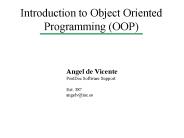Object vs Class composition - PowerPoint PPT Presentation
1 / 15
Title:
Object vs Class composition
Description:
Special interface between a class and its subclasses ... Acyclic graph = methods arranged in layers. Cycles = all methods form a group ... – PowerPoint PPT presentation
Number of Views:48
Avg rating:3.0/5.0
Title: Object vs Class composition
1
Object vs Class composition
- By Marine Ruhamanya
2
Disciplined Inheritance
- Problems with implementation inheritance
- Encapsulation
- Fragile Base Class problem
- However it is a powerful mechanism.
- Several attempts to discipline the mechanism
3
The specialization interface
- Special interface between a class and its
subclasses - C, Java, C support the notion of protected
features of a class
4
Typing the specialization interface
- Overriding methods needs to be done carefully
- Proposal (Lamping,1993)
- Type system to improve control
- Declare method dependencies
- Acyclic graph gt methods arranged in layers
- Cycles gt all methods form a group
- Subclass has to override methods group by group
5
Behavioral specification
- Semantic issues of implementation inheritance
- mostly related with re-entrance caused by
self-recursion - Proposal (Stata and Guttag, 1995)
- View a class as a combined definitions of
interacting parts objects - Division of labor or method groups
- No direct access between divisions
6
Behavioral specification(2)
- Use of specification techniques and the notion of
behavioral subtyping - Stata-Guttag vs Lampig
- Stata-Guttag split state and behavior into
groups. Methods groups encapsulate part of the
state - Lampig any dependency of methods on state
- Tight semantic control leads to object
composition.
7
Reuse contracts
- Less restrictive forms of implementation
- Proposal (Stayeart et al., 1996)
- Annotated interface reuse contracts
- Determine how reuse happens between classes and
its subclasses - Specify structural aspects of a base class
- Specify only the part of a call stucture
subclasses can rely on. - New set of modification operators
8
Representation Invariants Methods Refinements
- Proposal (Stephen, 1999)
- Associate invariants to a class specification
that refers to protected variables - Proposal (Stata, 1999)
- Separate the notion of subtyping and subclassing
to allow partial overriding - Supercalls are allowed if overriding method is a
proper refinement of the base class method.
9
Disciplined inheritance to avoid the FBC problem
- Proposal (Mikhajlov-Sekerinski, 1998)
- Set of rules
- Construction of subclasses based on superclass
specification - Eliminate the introduction of new cyclic method
dependencies - Superclasses instance variables are private and
subclasses dont introduce new ones. - Very restrictive, but interesting formal proof
10
Creating subclasses without seeing the superclass
code
- Proposal (Leavens et al., 2000)
- Java Modeling Language defined
- Focus on the inverse of FBC problem
- Provide 3 parts to a class specification
- 1st and 2nd public and protected parts
- 3rd subclassing contract provide information
accessed variables and methods call dependencies - Link to the FBC not further explored.
11
From Class to Object Composition
- Object composition - simpler form of composition
- Object send message to other object asking for
support - Outer and inner objects, forwading
- Differences to implementation inheritance
- Outer object does not reimplement inner object
functionality - Implicit self-recursion or possesion of common
self
12
From Class to Object Composition
- Implicit self-recursion or possession of
common self - There is no common self in object composition
- In implementation inheritance upcalls due to
method invocation - Example ( page 135).
- Advantage dynamic
13
Forwarding vs Delegation
- Message passing
- Delegation message-send is classified as either
regular (forwarding) or self-recursive
(delegation) - Example (page 136 137)
- Message resending
- Complexity exploses under delegation
- Interaction diagram similar to that of
implementation inheritance
14
Delegation Inheritance
- Delegation powerful programming tool
- System based on OC and delegation are highly
dynamic. - Languages are called prototype-based languages
e.g. Self. - Not yet mainstream
- Delegation is behind in discipline and modularity
while inheritance is behind in system dynamics
and late compsition
15
End































